by Holly Tse, CMP at www.chinesefootreflexology.com
If you get headaches or migraines, here are four acupressure and Chinese Reflexology points that can help you feel better right away.
Learn how to rub your feet for fast pain relief and for long-term improvement of your symptoms.
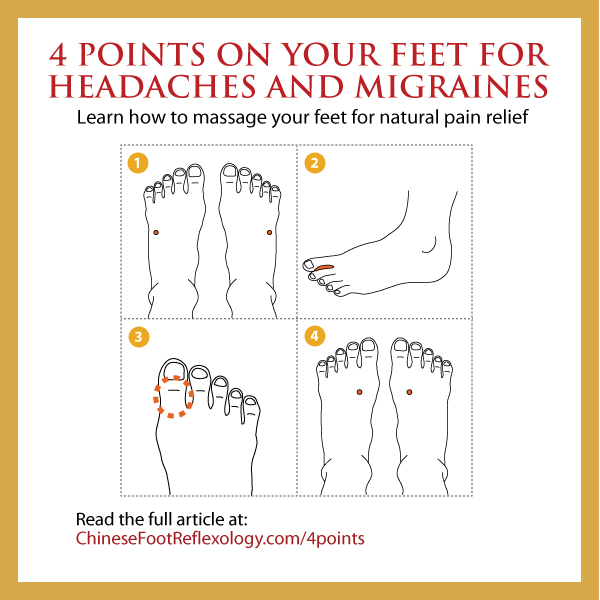
Let’s face it, headaches suck!
While I often write eloquently (or so I think!), there’s no other way to describe the stabbing pain that shoots up through your eye, the vise-like grip that radiates from your head to your shoulders or the incessant throbbing that leaves you feeling cranky, crabby and foggy.
If it sounds like I've experienced some killer headaches, your assumption is 100% correct. I've had stabbing migraines, headaches that follow you to sleep and greet you on waking, dull achy head pain, and ocular migraines too. Fortunately, I learned how to bring my body into balance so that I now can’t even remember when I last had a headache.
If it sounds like I've experienced some killer headaches, your assumption is 100% correct. I've had stabbing migraines, headaches that follow you to sleep and greet you on waking, dull achy head pain, and ocular migraines too. Fortunately, I learned how to bring my body into balance so that I now can’t even remember when I last had a headache.
Here are some good books on Reflexology
Complete Reflexology for Life
The Reflexology Atlas
Complete Reflexology for Life
The Reflexology Atlas
No one should have to suffer from headaches or migraines. It sucks the life right out of you and keeps you from doing the most basic day to day activities. That’s why I’m writing today’s article. Plus, one dear reader wrote to ask me how to use Chinese Reflexology for headaches. You know who you are, this article is for you. Thank you.
In this article, you’ll learn four acupressure and reflexology points on your feet that can help relieve your headache symptoms right away and also help alleviate your symptoms in the long-term. And, did you know that you can “cure” yourself and be headache and migraine-free? You’ll learn how right after the four points for pain relief.
Natural approaches to headache relief:
Acupressure Points and Home remedies for Health:
Acupressure Points for High Blood Pressure
Combat Stress and Food Cravings with Qi Massage
Energy Medicine and Home remedies for Dry Eyes
Chinese Medicine 101: Headache and Migraine Pain
Okay, I’m going to simplify thousands of years of Chinese Medicine into a few sentences. Make that, I’m going to try to do this! From a Traditional Chinese Medicine perspective, there is one main reason why people get headaches and/or migraines:
- Qi is not flowing smoothly through your head
So what does this mean? Qi is a word to describe your life force energy. Similar to how our bodies have a circulation system for blood, we also have pathways in our bodies for the flow of energy. When energy is not flowing as it should, it may eventually show up as physical symptoms in the body.













In the case of headaches and migraines, Qi is not flowing smoothly through the head.
If there’s too much Qi going up to the head and it’s getting “stuck”, this causes headaches or migraines with intense pounding, stabbing or throbbing pain. If not enough energy is flowing through the head, this causes headaches that tend to be chronic and more “mild” and achy in feel.
If there’s too much Qi going up to the head and it’s getting “stuck”, this causes headaches or migraines with intense pounding, stabbing or throbbing pain. If not enough energy is flowing through the head, this causes headaches that tend to be chronic and more “mild” and achy in feel.
The key to relieving the pain is to get the Qi flowing smoothly through your head.
How to build up Chi (Qi) to fight off illness
Eight Exercises for Fitness, Healing, and Longevity
QIGONG WALK to increase Qi (vital energy) quickly
Standing exercises (Zhan Zhuang) can positively affect every cell and every organ in the human body, improve the functioning of respiratory and vascular systems, and also improve metabolism. In other words, they activate the whole human organism.
Zhan Zhuang - foundation of Internal Martial Arts

In Chinese Medicine, the cure for headaches and migraines is based on figuring out what’s disrupting the flow of Qi and then balancing the whole body so that the Qi flows smoothly again.
In Chinese Medicine, the cure for headaches and migraines is based on figuring out what’s disrupting the flow of Qi and then balancing the whole body so that the Qi flows smoothly again.
CAUTION: Some of the points in this article are contraindicated (not to be used) when pregnant as they can induce labour because they really get the Qi flowing.
In some cases, a headache or migraine may indicate a serious medical condition. Consult your doctor if your headache is severe, is different from previous headaches or occurs with other symptoms such as those listed in this article on WebMD.
In a nutshell, if your head hurts and you’re not sure whether to see a doctor, please go see your doctor. Now that the common sense disclaimer is out of the way, let’s get to these acupressure and reflexology points for headaches and migraines.
1. Chinese Reflexology Point for Migraines (Temporal Area)
If you experience migraines or headache pain in the temporal area (sides of your head), this point is especially effective for moving the Qi to help you get relief.
The Chinese Reflexology point for Migraines (temporal area of your head) is located on the inside of your big toe between the big toe and second toe.
The Chinese Reflexology point for Migraines (temporal area of your head) is located on the inside of your big toe between the big toe and second toe.
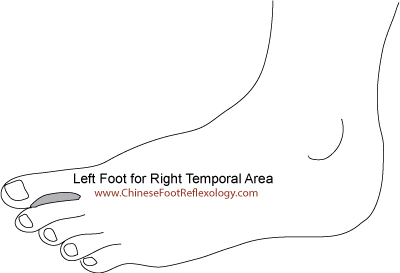 To massage this point, use your thumb to press and rub side to side on this area. Start at the tip of your toe and work your way down. When you get to the base of the toe, pick up your thumb, place it back at the top of the toe and repeat. Massage for 60 seconds to help smooth the flow of Qi.
To massage this point, use your thumb to press and rub side to side on this area. Start at the tip of your toe and work your way down. When you get to the base of the toe, pick up your thumb, place it back at the top of the toe and repeat. Massage for 60 seconds to help smooth the flow of Qi.
If you are experiencing headache or migraine pain on the left side of your head, rub the Chinese Reflexology point on your RIGHT foot and vice versa if it’s on the right side of your head. The reason why you rub the opposite foot is because the energy meridians cross each other at the neck and are thus flow through the opposite sides of your head. If you’re feeling pain on both sides, rub the points on both of your feet.
One thing to note is that this point is very likely going to be extremely sensitive to rub if you have a headache or get headaches frequently. Sensitive points indicate areas where Qi is not flowing smoothly. The more sensitive a point feels, the greater the disruption to the flow of Qi.
You can also rub this point daily even when you don’t have pain. The consistent massage will help the Qi to flow more smoothly through your temporal area and thus, help to alleviate your symptoms over the long-term.
2. Four Gates: Tai Chong (LV-3) and He Gu (LI-4)
The four gates are actually two acupressure points on your feet and two on your hands. They are commonly used in acupuncture to treat headaches.
WARNING: Do not massage the Four Gates points if you are pregnant. These points powerfully move Qi and are contraindicated (not to be used) when pregnant as they can induce labour.
Tai Chong (LV-3)
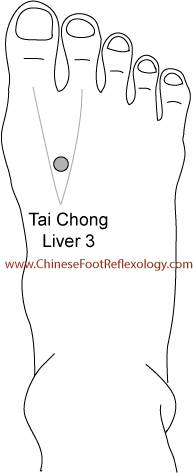 Tai Chong is also known as Liver 3 (LV-3) because it is located on the Liver meridian of your body. In Chinese Medicine, the Liver plays a key role in ensuring the smooth flow of Qi throughout the body.
Tai Chong is also known as Liver 3 (LV-3) because it is located on the Liver meridian of your body. In Chinese Medicine, the Liver plays a key role in ensuring the smooth flow of Qi throughout the body.
The point is located on the top of the foot in the webbing between the big toe and the second toe. Use your thumb to feel for the bones of the two toes into you feel where the bones intersect. Then slide your thumb about a thumb-width above this intersection and press the depression between the bones.
Press and hold for one minute. As mentioned in the Chinese Reflexology point for migraines (temporal area), you’ll press on the foot opposite to where you’re feeling pain in your head. Press Liver 3 on both feet if you are feeling pain on both sides of your head.
He Gu (LI-4)
He Gu or Large Intestine 4 (LI-4) is a bonus point I’m including because it’s actually located on your hands. Combined with LV-3, these points are very powerful for moving Qi and are known as the Four Gates.
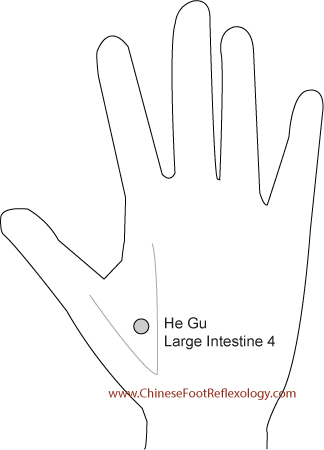 Large Intestine 4 is located on the top of the webbing of your hand between the thumb and index finger. It’s like the Liver 3 of the hand. An easy way to locate this point is to press your thumb and index finger together. This will cause the muscle to bulge upwards. LI-4 is located on the highest point on the bulge.
Large Intestine 4 is located on the top of the webbing of your hand between the thumb and index finger. It’s like the Liver 3 of the hand. An easy way to locate this point is to press your thumb and index finger together. This will cause the muscle to bulge upwards. LI-4 is located on the highest point on the bulge.
Press on this area with your opposite thumb. Then relax your thumb and index fingers as you press and hold this point for 60 seconds. Remember the “opposite rule” for where to press depending on where you’re experiencing pain.
Reminder: Please do not press this point if you are pregnant.
3. Zu Ling Qi: (GB-41)
The English translation for Zulingqi is “foot overlooking tears”. It’s aptly named because when you press this point, it’s likely be so sensitive that it will bring tears to your eyes. While there is a saying, “No pain. No gain.” please use your common sense and go with what feels comfortable. It’s better to err on the lighter side than to press too hard or for too long.
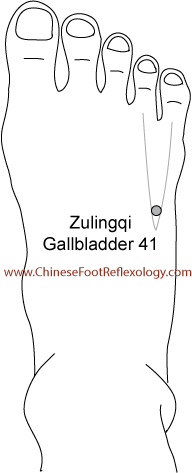 Zu Lin Qi or Gallbladder 41 (GB-41) is located on the top of the foot between your pinky toe and second last toe. To locate GB-41, feel along the top of your foot for the bones of your pinky toe and second last toe. They’ll form a “V” where they intersect.
Zu Lin Qi or Gallbladder 41 (GB-41) is located on the top of the foot between your pinky toe and second last toe. To locate GB-41, feel along the top of your foot for the bones of your pinky toe and second last toe. They’ll form a “V” where they intersect.
Gallbladder 41 is just above the point of intersection. Feel in the webbing for a slight depression. It will be just outside the tendon in your foot. It’s okay if you can’t feel the tendon. As long as you are just above where the V intersects, you’re close enough as the entire Gallbladder meridian runs through this area. Once you locate this point, press and hold for 30 to 60 seconds.
Do I need to mention about the opposite foot? I think you’ve got this down by now. Psst… I won’t even mention it for the last reflexology point.
Because the Gallbladder meridian is paired with the Liver meridian, this point will benefit the flow of Qi. The Gallbladder meridian also runs through the side of your head and right through your forehead so it’s very beneficial for headaches to get Qi flowing smoothly through this channel. This is also a good point for menstrual issues, so if you get headaches with your period, this is a beneficial point to press.
Shop KEYLIME Yoga Wear
Shop KEYLIME Yoga Wear
4. Chinese Reflexology Point for the Face
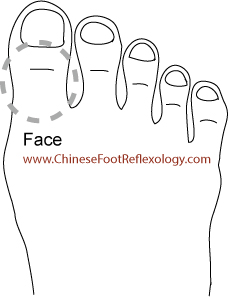 If you are experiencing headache or migraine pain in your face, the Chinese Reflexology point for the face is a good one to massage. The top of your big toe corresponds to your face, all the way from your forehead to your neck.
If you are experiencing headache or migraine pain in your face, the Chinese Reflexology point for the face is a good one to massage. The top of your big toe corresponds to your face, all the way from your forehead to your neck.
Since it’s not convenient or recommended to massage the toenail, this point is best for just below the eyes, in your cheeks, the jaw area and the front of your face. Use your thumb to rub the top of your big toe, side to side, working your way from the base of the toenail to the base of the toe. When you get to the bottom of the toe, start again at the top. Repeat for 30 to 60 seconds.
The “Cure” for Headaches and Migraines
Congratulations! You’ve just learned 4 (actually five if you include He Gu on the hand) points to get your Qi moving smoothly again so that you can get natural relief from headaches and migraines.
At the beginning of this article, I promised to discuss the headache and migraine “cure.” The reason I put the word cure in quotations is because Traditional Chinese Reflexology is not about diagnosing diseases and curing them.
Fundamentally, the focus of this healing modality is to bring your whole body into balance by getting your Qi flowing properly.
When Qi is flowing as it should, your body will be in a state of health and well-being. Chinese Reflexology is about finding Qi disharmonies and clearing them in order to support and promote your body’s natural healing process.
The “cure” for headaches and migraines is as simple as getting your Qi flowing smoothly through your body and your head. Then, presto! No more headaches or migraines.
Ultimately, your body wants to be in a state of balance and harmony and Chinese Reflexology helps you achieve this. There are so many underlying reasons and factors why someone’s Qi can be out of balance. (e.g. too much qi, not enough qi). Diet, lack of exercise (or even too much exercise), stress, worry, emotions, environment — all of these things affect the flow of Qi in your body.
If you try to figure what the problem is, you can start over thinking things, which can also then impede the flow of Qi in your body! Fortunately, with Chinese Reflexology, when you massage all of the points on your feet, it doesn't matter what is it out of balance or how it’s out of balance.
Simply massaging the reflexology point will help to balance the flow of Qi.
Another great point to massage is Kidney Point
The Key to Longevity - The kidneys
Another great point to massage is Kidney Point
The Key to Longevity - The kidneys
Then, your body can then focus on what it does best, which is heal itself. And that’s why Chinese Reflexology is an excellent companion to almost any healing practice (Western or holistic). It simply helps your body to heal itself.
More Exercises and Tips for Energy Flow(Qi) Cultivation:
3 Tao Longevity Practices (Free Instructions and Video)
Spring Qigong for Your Liver
What is stronger Qigong or Coffee for an instant “hit”?
Heal With Qigong!
Resources:









Acupressure Mat with Magnets Pyramids for Pain Relief 
Reflexology Walk Stone Foot Massage Mat
Massage Acupressure Foot Slippers
Mood Boost Natural Stress and Anxiety Relief 
Exercises and Tips for Energy Flow(Qi) Cultivation:
Try In-bed Health-preserving Morning Massage
The Key to Longevity - The kidneys
Eight Exercises for Fitness, Healing, and Longevity
QIGONG WALK to increase Qi (vital energy) quickly
How to build up Chi (Qi) to fight off Illness
Standing Qigong produced superior results
What is stronger Qigong or Coffee for an instant “hit”?Heal With Qigong!
Nuphorin™ Fast-Acting Anxiety Relief ✭ Pharmaceutical Grade Formula
Worlds Most Extraordinary Qigong Techniques - Ebook
Qigong For Happiness, Health And Vitality - Ebook
Set Of Videos Teaching Qi Gong for Health
Binaural Beats For Meditation, Weight Loss, Healing and more - Free Sample
Get Your "Black Belt" In Taboo Physics - Plus - Free Energy Secrets, Renewable
Qigong, The Secret of Youth: Da Mo's Muscle/Tendon Changing and Marrow/Brain Washing Classics
Frontier Thyme Leaf Certified Organic, 16 Ounce Bag
Foundational Practices to Awaken Chi Energy
Chinese Esoteric Art of Health and Longevity
Taoist Meditation and Longevity Techniques
A Taoist Guide to Longevity
The Shaolin Qigong Workout For Longevity




Reflexology Walk Stone Foot Massage Mat
Massage Acupressure Foot Slippers
Mood Boost Natural Stress and Anxiety Relief

Exercises and Tips for Energy Flow(Qi) Cultivation:
Try In-bed Health-preserving Morning Massage
The Key to Longevity - The kidneys
Eight Exercises for Fitness, Healing, and Longevity
QIGONG WALK to increase Qi (vital energy) quickly
How to build up Chi (Qi) to fight off Illness
Standing Qigong produced superior results
What is stronger Qigong or Coffee for an instant “hit”?Heal With Qigong!
Nuphorin™ Fast-Acting Anxiety Relief ✭ Pharmaceutical Grade Formula

Worlds Most Extraordinary Qigong Techniques - Ebook
Qigong For Happiness, Health And Vitality - Ebook
Set Of Videos Teaching Qi Gong for Health
Binaural Beats For Meditation, Weight Loss, Healing and more - Free Sample
Get Your "Black Belt" In Taboo Physics - Plus - Free Energy Secrets, Renewable
Qigong, The Secret of Youth: Da Mo's Muscle/Tendon Changing and Marrow/Brain Washing Classics

Frontier Thyme Leaf Certified Organic, 16 Ounce Bag

Foundational Practices to Awaken Chi Energy

Chinese Esoteric Art of Health and Longevity

Taoist Meditation and Longevity Techniques

A Taoist Guide to Longevity

The Shaolin Qigong Workout For Longevity

Books and DVDs on Qigong:
Qigong Meditation: Small Circulation
Livelight ~ Yoga and Meditation Music
Wuji Qigong Meditation
Spring Forest Qigong - Small Universe - Meditation
Three Treasures Qigong Healing Meditation
Qigong Meditation: Embryonic Breathing
Qigong Meditation: Small Circulation

Livelight ~ Yoga and Meditation Music

Wuji Qigong Meditation

Spring Forest Qigong - Small Universe - Meditation

Three Treasures Qigong Healing Meditation

Qigong Meditation: Embryonic Breathing

Sources:
Journal of Evidence-Based Complementary and Alternative Medicine – http://www.hindawi.com/journals/ecam/2013/945063/
Acupuncture and Auricular Therapy & Auricular Medicine – http://www.auriculartherapy.com/articles/shenmen.html
Atlas of Human Anatomy: Including Student Consult Interactive Ancillaries and Guides, 6e (Netter Basic Science)

Auriculotherapy Manual: Chinese and Western Systems of Ear Acupuncture, 4e

1998.www.auriculotherapy.com, FAQs, Terry Oleson, PhD, 2006.


Great points to use for sure. Another way look at it is to ask what is causing these meridians to be out of balance. Since the body follows the mind I would suspect some mental or spiritual stress.
ReplyDeleteThis was really helpful and informative! I really liked your 5 minute meditation post as well! I am going to Pin them both for future reference! :)
ReplyDeleteAcupressure is 1 such technique used to relieve the meridians of blockage and increase the flow of energy, which, in turn, releases endorphins, your body's natural pain killer. With a little knowledge of where the pressure points are in your body, you can relieve the pain of migraines using acupressure.
ReplyDeletealternative medicine la jolla
Bagus sekali artikelnya ijin share ya kawan.. - http://essenaquatic.xyz
ReplyDeleteA migraine headache, often described as an intense throbbing or pulsing on one side of the head, is commonly accompanied by nausea, vomiting, and extreme sensitivity to light and sound. A migraine attack can last for hours or days, and often require a day’s recovery. Natural migraine treatment is safe and has the ability to attach to human serotonin receptors to help reduce migraine triggers that cause migraine pain. visit http://www.hashmidawakhana.org/natural-remedies-for-migraine-headaches.html
ReplyDeleteacupressure is a way that can help you to solve many of your body problems like acupressure for knee pain, acupressure for blood pressure, acupressure for belly fat and etc.
ReplyDeletenice article,.
ReplyDelete